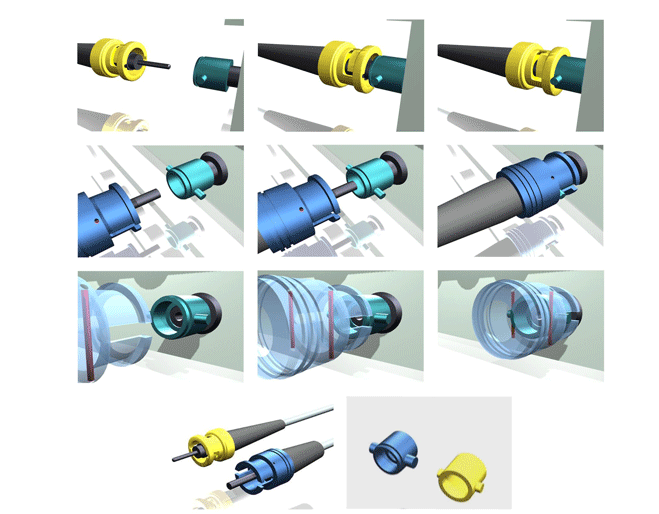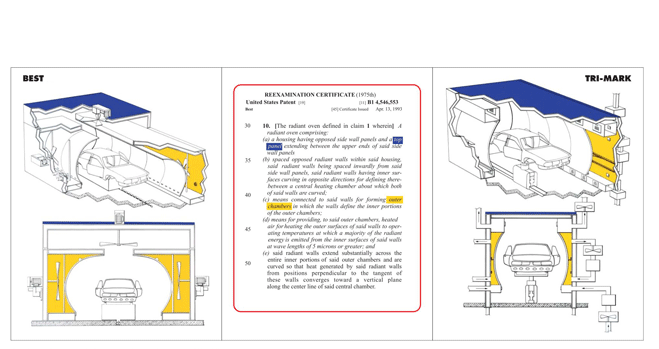How to transition patent drawings into persuasive courtroom exhibits
Patent Drawings to Persuasive Litigation Graphics
Whether you are pursuing an infringer or defending your patent, drawings can help educate a judge or jury. Simple, clear and accurate images can often help you win the day. Whether deciding on what damages are appropriate or if in settlement negotiations, a well-defined patent enables the owner to negotiate for the best result possible.
Litigation is, of course, the worst case scenario. It is preferable to deter a potential infringer before he or she ever gets started. Professionally prepared patent drawings may make an infringer think twice about copying an idea when the patent is clear and unambiguous. The earlier an infringer is deterred the better for the patent owner.
If your case goes to trial, your application containing accurate, clear patent drawings is critical. “When the jury goes to the jury room, where no attorney or judge will be speaking to them, they will take with them the patent”1. In many jurisdictions the jurors do not take trial exhibits to the jury room, however, they often will have a copy of the patent itself with the complete set of drawings.
Precise patent drawings also make it easier to generate trail graphics. Less guesswork equals less time which results in less cost for litigation graphics. If the patent drawings were created in computer-aided design and drafting (CADD) software, the files can usually be used to create litigation graphics without having to recreate them from scratch.
Many patent drafters are themselves skilled at creating litigation graphics. Additionally, the drafter that created your patent drawings is already familiar with the invention and will spend less time to figure it out. That being said, we do not recommend you simply enlarge your patent drawings. What may be clear to an examiner may not be clear to a judge or jury.
Effective Litigation graphics will aid in the understanding of subtle differences or similarities between the accused invention and/or the prior art. It should inform, educate and persuade your audience, be it a mediator, arbitrator, judge or jury.
There are many creative methods a skilled draftsperson can use to create visually pleasing, persuasive courtroom exhibits. The more complex and less defined the case, the more valuable the draftsperson in making constructive proposals. The technique used to present the information, be it high tech 3D animation or low tech blow up charts, to a certain extent depends on the message you wish to convey. For instance, is your aim to present the patent holders invention clearly or convey highly technical information from the patent? Or if you are faced with patent infringement issues against your product, highlighting/emphasizing known patents, products or publications prior to the filing date could help invalidate the patent. To emphasize, you may make the item bigger, clearer, or placed in front, bright colors can be used to highlight. Decisions about scale, placement of image, style and colors will all go towards how the images will be perceived. Visual reinforcement through repetition, theme and scale can strengthen recall in a jury room. Consistency of presenting an item/product throughout will help in recognizing and remembering it.
Many choices are available in the type of exhibits that will best portray your evidence and argument. Budget often being a deciding factor; makes it a good idea to get a detailed proposal upfront.
You have many choices:
- Charts and graphs can be used to simplify complex information, making it more interesting and easy to understand.
- Timelines are a good way to display a list of events in chronological order.
- 3D animations are powerful visual tools and can be used to show the workings of a product or to enable a better understanding of how the technology works.
- Photorealistic animations can show if and to what extent one product is similar or different to another.
- Other choices include PowerPoint presentations, enlargements, photographs, working models and interactive exhibits.
In the case of design patents, infringement is typically based on the design patented and generally does not require proof of unfair competition.
Design patents are very different from utility patents. The application relies fully on the drawings.
According to the USPTO guidelines “the drawing disclosure is the most important element of the application”2 and the drawing or photograph in a design patent application “constitutes the entire visual disclosure of the claim”3. It is of utmost importance that the drawings are so well executed “that nothing regarding the design sought to be patented is left to conjecture”4.
The current design patent infringement test, known as the ordinary observer test from Gorham Co v White declares that there was infringement if “in the eye of an ordinary observer giving such attention as a purchaser usually gives, two designs are substantially the same”, in other words, are the two designs substantially the same in the eyes of an ordinary observer.
Design patent litigation is about assessment of design and form and visual examples of the product. The aim of litigation graphics should be to show two designs as substantially the same or substantially different.
Conclusion
A competent drafting firm will have the experience and skills that help you not only during the patent process but over the life of the invention.
Good patent drawings make for good applications and for good defenses when necessary.
Endnotes
- Article Invention-Aimed Patent Drawings for More Lucid Comprehension by Gregory T. Kovounas of IMPINJ, Inc, and Carl K. Turk of Merchant & Gould, PC, available in, Intellectual Property Today, Issue: November 2006.
- USPTO A Guide to Filing a Design Patent Application, § Drawings or Black & White Photographs (3)
- USPTO A Guide to Filing a Design Patent Application, § Drawings or Black & White Photographs (3)
- USPTO A Guide to Filing a Design Patent Application, § Drawings or Black & White Photographs (4)
Infringement case studies

Frames from an animation illustrate the difference and incompatibility between two connectors.
Even though the two connectors look similar, the animation demonstrates that they work differently.
Transparency shows the inner workings and a final side by side view emphasizes differences between the two.

Color is used to emphasize similarities.
Side by side placement and the same scale helps to draw attention to likenesses.
The same orientation and execution of illustrations establish the same look and feel for both products, highlighting similarities.

